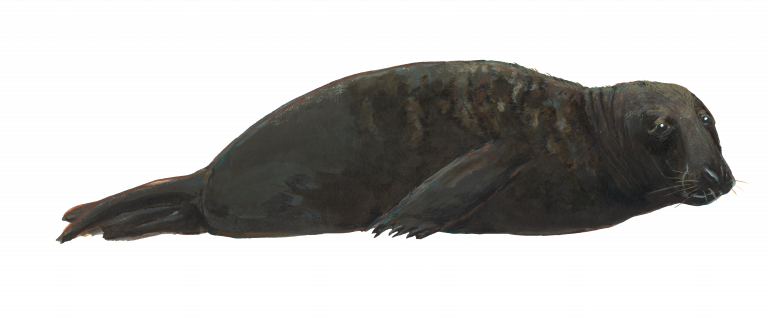Learning how to seal is easy! There’s plenty of positive action you can take to protect seals and their natural habitats – and maybe even lend a flipper to improve them. To steer clear of blubbery blunders and ensure the well-being of seals in the wild, follow our guide and you’ll be prepared for your seal-watching trip like a true pinniped pal!

Sealiously Don't
Don't chase or throw me into the water! I'm here for my land nap, and I need time to rest, or I will get super exhausted.
Seals need to haul out on land for a variety of reasons: to rest and replenish oxygen after diving, to nurse pups, or to molt. This is perfectly normal behavior and doesn’t mean they are sick. They will not be better off in the water. Seal pups are especially vulnerable, as they don’t have the endurance and insulation for long swims yet.
Don't touch me or pick me up! I know I look cuddly and totally friend-shaped, but you are tall and scary (also, I have mean teeth and I will use them).
Seals are wild animals and don’t like getting touched. If they feel threatened or unwell, they might bite (and give you a nasty infection). Seal pups alone on the beach should never be picked up or disturbed; their mom might be nearby but can be frightened away by humans and not come back. There are many countries where approaching a marine mammal is prohibited, too.
Don't let your dog run up to me, and please put them on a leash! We might both be puppers, but playtime together is a bad idea and puts us both at risk.
Apart from disturbing them, dogs can cause bite injuries to seals (and vice versa!), and seal bites can carry some nasty bacteria. Wild seals are large predators that can and will bite if they feel threatened. There’s also the risk of diseases that can pass between seals and dogs. And between seals and you, too!
Don't leave waste on the beach where I live. I'm extra curious and like to check things out, but if I get entangled, I'll have a hard time freeing myself because my flippers are not really nimble.
Most seals are curious, and they like to twirl seaweed around themselves in play. What’s fun with seaweed can be fatal with plastic waste. They often get entangled around their neck or flippers, and apart from restricting their movement, this can lead to horrific ingrown wounds. Items that cause the most harm (apart from fishing gear) are flying rings and other ring-shaped objects and pieces of string/rope. Consider avoiding those completely or at least on the beach, because you’ll never know where they might end up.
Don't feed me! If I'm hungry, I'll go on a foraging dive, and I should not have what you have anyway.
It’s highly unlikely you have food suitable for a seal with you, and you can potentially harm them with human food. Even more important, if they get used to humans giving them food, their behavior will change permanently in ways that make their lives more dangerours, and human-seal coexistence on the beach will be much harder in the future.
Don't post my location online, and please, no "sealfies". You don't want a photo with a spooked seal, right?
If you post a seal’s location or publish selfies with a seal, it will just encourage more people to seek it out and do the same. Especially if it’s a pup, it has a hard enough life and might end up where a lot of people frequent the beach due to inexperience. Don’t add to the load! If a seal appears to be in distress, share its location with a rescue organization instead.
Don't share problematic content. If something was filmed while harrassing me, sharing and liking will lead to more pestering.
There are a lot of social media photos and videos that involve disturbing, harrassing, and harming wild seals. It might look harmless at first glance, but people being close to seals is often a telling sign they are not caring for the seal’s well-being. The same goes for drones flying so close that they startle the seal. Look out for ethical photographers who share that they are having seal encounters on the terms of the animal, and are using equipment to zoom in without disturbing seals. If you want to make sure you are being an ethical photographer, check out this flyer!
Seally Do
Do bring a camera with a zoom lens (or binoculars) to capture my adorable whiskers - but please, keep your distance! I promise I look good from afar.
Watching seals on the beach is ideally not mutual. Seals feel more vulnerable on land and are prone to fleeing to the water if they perceive a threat. This costs them valuable energy, so it’s best if they don’t notice you. Signs that you are too close are: yawning, flipper raising, looks in your direction, retreat. An easy way to judge the right distance is the rule of thumb: can you still block the seal from your sight with your outstrechted thumb? Then you’re good! Bonus points if you can also keep it quiet. (And if you operate a drone, keep it at least at 110 m height, too.)
Do call a seal rescue center if I'm entangled or have injuries, but please don't attempt a rescue yourself. It might stress me out and cause me to flee to the water where I can't get help.
Not every seal on the beach needs help, but if you are worried, most rescue centers have hotlines and might even send an expert to assess the situation (or tell you what to do). You can find ways to contact the nearest stranding response team here, or you can read our guide about identifying seals in need of help and reacting the right way.
Do cuddle a seal plushie. If you need that sealy hug, plush seals are completely save and love to be petted (unlike me!)
As seals should never be disturbed, no matter how friend-shaped, a seal plushie is a good alternative. There are a huge variety of different ones to choose from. Consider getting one from the gift shop of a seal rescue center (a lot of them sell online, too), so your new little plush friend does support actual wild seals.
Do join a beach clean-up or pick up waste on your own. I'm grateful for every bit of trash that's not around when I come to spend my nap-time on the beach.
Environmental organizations or rescue centers might suggest beach clean-up days as fun community events you can join, but it’s just as easy to go alone or with friends, or bring a trash bag (and maybe a grabber) to the beach whenever you go. Apart from strings, webbing, and all kinds of ring-shaped trash, look out for trash that could injure seals when they are moving across the beach on their bellies.
Do make environmentally friendly life choices. Whether it's reducing waste, saving energy, or eating with an awareness for the ocean - what helps my coastal habitat will help me thrive!
Ocean and coast habitats are under threat due to many complex, systemic problems that are hard to address as an individual, but there are still things you can do. Two seal-related choices you can make concern waste (try to reduce single-use plastics) and seafood (try to reduce your seafood intake or at least look for ethical choices – seals suffer from overfishing, end up as bycatch in fishing nets, and often get entangled in fishing gear.)
Do take action with governments and your representatives. I need all the protection I can get, and so does my habitat.
A lot of problems concerning climate change and ocean protection are ideally addressed on a national or even international level. Join calls to action started by marine conservation organizations, and be on the lookout for the following topics to get in touch with representatives: suspension of protective laws for marine mammals; calls for seal cullings; trade with seal products; deregulations for protected areas.
Donate or find other ways to help organizations that help me.
The Seal Signal has a whole section dedicated to supporting seal conservation projects and rescue centers. It could be volunteering if you live nearby, donating (caring for seals is expensive!), or simply raising awareness about proper Seal Etiquette. A lot of people don’t know!
